Related Research Articles
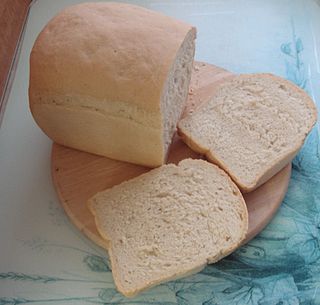
Baking is a method of preparing food that uses dry heat, typically in an oven, but can also be done in hot ashes, or on hot stones. The most common baked item is bread but many other types of foods are baked. Heat is gradually transferred "from the surface of cakes, cookies, and breads to their center. As heat travels through, it transforms batters and doughs into baked goods and more with a firm dry crust and a softer center". Baking can be combined with grilling to produce a hybrid barbecue variant by using both methods simultaneously, or one after the other. Baking is related to barbecuing because the concept of the masonry oven is similar to that of a smoke pit.

An apple pie is a pie in which the principal filling ingredient is apples. The earliest printed recipe is from England. Apple pie is often served with whipped cream, ice cream, or cheddar cheese. It is generally double-crusted, with pastry both above and below the filling; the upper crust may be solid or latticed. The bottom crust may be baked separately ("blind") to prevent it from getting soggy. Deep-dish apple pie often has a top crust only. Tarte Tatin is baked with the crust on top, but served with it on the bottom.

A king cake, also known as a three kings cake, is a cake associated in many countries with Epiphany. Its form and ingredients are variable, but in most cases a fève such as a figurine, often said to represent the Christ Child, is hidden inside. After the cake is cut, whoever gets the fève wins a prize. Modern fèves can be made out of other materials, and can represent various objects and people.
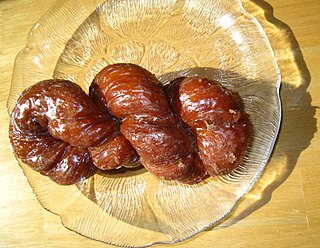
A cruller is a deep-fried pastry like a doughnut popular in the US and Canada often made from a rectangle of dough with a cut made in the middle that allows it to be pulled over and through itself, producing twists in the sides of the pastry. The cruller has been described as resembling "a small, braided torpedo". Some other cruller styles are made of a denser dough somewhat like that of a cake doughnut formed in a small loaf or stick shape, but not always twisted. Crullers may be topped with powdered sugar or icing.

A cupcake is a small cake designed to serve one person, which may be baked in a small thin paper or aluminum cup. As with larger cakes, frosting and other cake decorations such as fruit and candy may be applied.

A mille-feuille, vanilla slice or custard slice, similar to but slightly different from the Napoleon, is a pastry whose exact origin is unknown. Its modern form was influenced by improvements made by Marie-Antoine Carême.
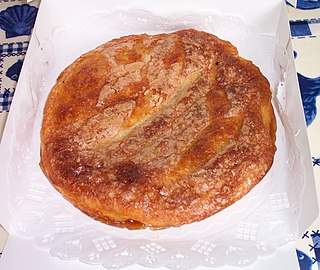
Kouign-amann is a sweet Breton cake, made with laminated dough. It is a round multi-layered cake, originally made with bread dough, containing layers of butter and incorporated sugar, similar in fashion to puff pastry, albeit with fewer layers. The cake is slowly baked until the sugar caramelizes and the recipe's butter expands the dough, resulting in its layered structure similar to a muffin-shaped, caramelized croissant.

A fat rascal, closely related to the historical turf cake, is a type of cake, similar to a scone or rock cake in both taste and ingredients. It originated in Yorkshire at least as early as the 19th century.
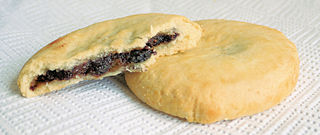
Chorley cakes are flattened, fruit filled pastry cakes, traditionally associated with the town of Chorley in Lancashire, England. They are a close relative of the more widely known Eccles cake, but have some significant differences. The Chorley cake is significantly less sweet than its Eccles cousin, and is commonly eaten with a light spread of butter on top, and sometimes a slice of Lancashire cheese on the side.
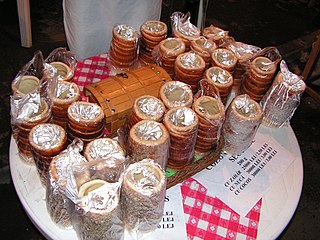
Kürtőskalács is a spit cake specific to the Székelys of Transylvania. Originally popular in the Hungarian-speaking regions of Romania, more predominantly the Székely Land, it became popular in both Romania and Hungary. The first written record dates back to 1679 and was found in the village of Úzdiszentpéter, while the first recipe appears in a manuscript cookbook dated in 1781. Earlier a festive treat, now it is part of everyday consumption. In Transylvania, a similar pastry to Kürtőskalács is Baumstriezel, originating from the Saxon communities.

Nun's farts are a dessert pastry originally from France, where they were known as pets-de-nonne, and which are now also produced in French Canada, the United States, England, and Spain.

The fourth series of The Great British Bake Off began airing on 20 August 2013. Mel Giedroyc and Sue Perkins again presented the show and Mary Berry and Paul Hollywood returned as judges. As with series three, the competition was held at Harptree Court in East Harptree, Somerset.

Christina Tosi is an American chef, author, and television personality. She is the chef, founder, owner, and CEO of Milk Bar, the sister bakery to the Momofuku restaurant group, with seventeen locations across North America. She is influential in the culinary industry, and was featured on Food & Wine magazine's list of "Most Innovative Women in Food and Drink" in 2014.

The fifth series of The Great British Bake Off first aired on 6 August 2014, with twelve contestants. Mel Giedroyc and Sue Perkins presented the show and Mary Berry and Paul Hollywood returned as judges. Twelve contestants competed in this series, and the competition was held in Welford Park in Berkshire. The series was won by Nancy Birtwhistle, with Luis Troyano and Richard Burr finishing as runners-up.

The sixth series of The Great British Bake Off first aired on 5 August 2015, with twelve contestants competing to be the series 6 winner. Mel Giedroyc and Sue Perkins presented the show, and Mary Berry and Paul Hollywood returned as judges. The competition was held in the ground of Welford Park, Berkshire for a second year. The series was won by Nadiya Hussain, with Tamal Ray and Ian Cumming finishing as runners-up.
The seventh series of The Great British Bake Off aired from 24 August 2016, with twelve contestants competing to be crowned the series 7 winner.

The ninth series of The Great British Bake Off began on 28 August 2018, with this being the second series to be broadcast on Channel 4. The series is presented by Noel Fielding and Sandi Toksvig, with judges Paul Hollywood and Prue Leith. This series saw a few changes to the usual format: the first episode being Biscuit Week, the documentary inserts were dropped, and the finale included the competitors doing a technical challenge outside the tent for the first time.
References
- ↑ White, Florence, ed. (1968). Good Things in England. London: The Cookery Book Club. p. 356.
- ↑ Rodger, James (May 1, 2015). "What is a Coventry God Cake? How do you make one?". Coventry Telegraph. Retrieved April 28, 2017.
- ↑ Taggart, Caroline (March 28, 2014). "Let them eat British cake! Blighty's traditional teatime treats rediscovered". Express. Retrieved April 28, 2017.
- ↑ Griffin, Mary (April 11, 2014). "God-ly treats that deserve a big revival". Birmingham Post. Retrieved April 28, 2017.
- ↑ "Coventry God Cakes | Visit Coventry and Warwickshire". www.visitcoventryandwarwickshire.co.uk. Retrieved 2017-04-28.